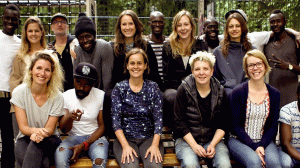Have you ever had a job that was not the right fit? Did you feel out of sync with how people in your organization did things or treated each other, but could not quite put your finger on the broader problem? Until recently, I chalked these feelings up to a personal misfit with the job description or between personalities. However, while taking a class called “Leading for Impact,” I realized that there might be an additional systemic level to consider – one that can help explain why sometimes, individuals and organizations amazingly click, while others falter.
Shelley Brickson developed a framework that changed how I look at organizations. Her concept is straightforward: Like individuals, organizations have distinct identity orientations that define who they are vis-à-vis their internal and external stakeholders (e.g., employees, customers, or society). There are three pure types of organizational identity orientations: individualistic, relational, and collectivistic. These guide the logic of an organization’s actions, define the basis of its relationships, and create a distinct form of societal impact.
We can analyze each identity orientation based on several questions: What are the characteristics and mindsets of people who excel in this type of organization? What do relationships between colleagues look like? What describes the employment relationship? What value does this type of organization create for its employees and stakeholders? Here is a (very abbreviated) overview of the three types, assuming they are managed to their highest potential. You can find Brickson’s full academic article here.
Individualistic identity orientation, aka “we are the best in our industry”
Employees in individualistic organizations tend to be achievement-driven, competitive, self-assured, and motivated by self-interest. Colleagues share excitement about their challenging work, connect through being in the trenches together, and have deep respect and trust in each other’s abilities. The employment relationship is transactional: Employers expect employees to give their best, take on responsibility, and innovate. Individualistic organizations strive to create a culture that encourages reasonable risk-taking and failure, valuing openness and candor.
In return, employees expect exciting work with a high level of autonomy and significant monetary compensation. Employees are evaluated based on performance and rewarded with money and personal development opportunities. To create value, individualistic organizations meet employees’ need for personal esteem, deliver high-quality products and services to clients, increase economic opportunities within communities, and accelerate advancement through innovation.
Relational identity orientation, aka “we want you to bring your whole self to work”
Employees in relational organizations are altruistic, empathic, family-oriented, and motivated by serving their colleagues and clients. Colleagues support each other emotionally, forming caring relationships as part of a “work family.” They trust everyone to be there for one another and expect their individual needs to be respected and fulfilled. Employers demand collaboration and loyalty.
In exchange, they act as caretakers and consider their employees as whole human beings beyond work-related performance. Work-life integration is considered central to employee satisfaction and employees expect flexibility to fulfill both their personal and professional roles. Performance evaluation is conversation-based, and mentoring is an integral approach to development. Relational organizations create value for employees by meeting their need for understanding, care, and interpersonal learning. External stakeholders also benefit from these nurturing relationships by receiving high-quality products and services tailored to their individual needs.
Collectivistic identity orientation, aka “we are using business as a source for good”
Employees in collectivistic organizations can be characterized as harmonic, inclusive, consensus-oriented, and motivated by the wish to enhance their group’s welfare. Colleagues believe in equality among the group’s members, consider the group more important than its individuals, and are connected by their desire to advance a common agenda. Collectivistic organizations can be employee-owned, and teams – the unit in which participation and decision-making occur – are at their heart. Employees are socialized through events and often engage in community service as a group.
Collectivistic employers expect employees to contribute to their teams and act as responsible members of society, while employees rely on the organization to uphold its values and meet their need for belonging. Externally, these organizations create social capital, thereby advancing their organizations’ causes.
Ok, and where do we go from here?
While reading the above, you might have asked yourself: Where do I fit? How would I classify my current employer? What are the strengths and weaknesses of each identity orientation? While the descriptions illustrate pure types (and hybrids exist, too), the general framework can guide you to reflect on past experiences and help in future decision-making. For example, if you are looking for a new job, I see three steps to practically apply these research insights:
1. Understand Yourself
Instead of mainly focusing on the responsibilities and required skills of a job description, ask yourself some tough questions: Who am I, and what is important to me? How would I describe my own identity orientation? What must an organization look like for me to want to work/volunteer/partner with it? Some practical starting points to help find answers are CliftonStrengths, the University of Michigan’s Reflected Best Self Exercise, or establishing a True North Group or board of advisors.
2. Explore Potential for Alignment
Could we be a match? When trying to find out more, I suggest paying close attention to the organization’s language in its job descriptions and website. These words can be the first clue to uncovering its identity orientation. In a personal conversation, you can dig deeper and frame your questions to target the employment relationship, relationships between colleagues, and value creation. Speaking with current and former employees to focus on cultural aspects of the job usually produces insights, too.
3. Reflect Regularly
We all are a work in progress, so it should not be surprising that our needs change over time. Perhaps we start out somewhere, feel aligned with the organization’s identity, but diverge after several years. Different identity orientations might have a different level of attractiveness for us depending on where we are in life and what is important to us. Therefore, regular reflection is necessary.
Give it a try
Learning about identity orientations has fundamentally changed my thinking about myself, organizations, and how I evaluate what it means to be a “good fit.” I find it a useful framework regardless of whether you are looking for a new job, hiring someone, building a new business, considering which organization to partner with, or where to volunteer. I encourage you to give it a try and see if the steps above can bring you closer to being your authentic self at work.
About the Author
Charlotte Carnehl has been working in the nonprofit sector since 2015. Over the last year, she pursued an MBA at the University of Illinois Chicago (and is thankful for the support of the Hans Weisser Stiftung). This article is a first attempt to share her new knowledge with others.










